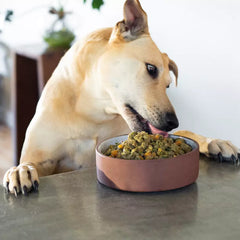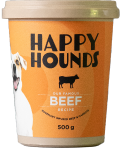Shop

Foods to Avoid for Adult Dogs and Puppies: A Comprehensive Guide
October 08, 2024 3 min read
As pet parents, it’s our responsibility to shower our dogs with love and keep them nourished. While dogs are omnivorous and benefit from fruit and veggies in their diet, there are foods that they can’t stomach. The following foods are staples in many households so make sure they’re out of reach of curious noses and that your dog doesn’t eat scraps off the floor while you’re cooking or eating.
Dogs Can’t Eat These…
Chocolate: Most people are aware that chocolate is a big no-no. It contains theobromine and caffeine, both of which are toxic to dogs. Even small amounts can cause symptoms such as vomiting, diarrhoea, rapid breathing, and muscle tremors. Dark chocolate is particularly dangerous due to its higher concentration of these compounds.

Grapes and raisins: These fruits can cause acute kidney failure in dogs. While the exact substance causing this reaction is unknown, even a small amount can be harmful. Symptoms of grape or raisin poisoning include lethargy, vomiting, and loss of appetite.

Onions, garlic and leeks: These foods are part of the Allium family and can damage your dog’s red blood cells, leading to anaemia. Symptoms to watch for include weakness, lethargy, and a decrease in appetite. It doesn’t matter whether the onions or garlic are raw, cooked, or powdered so be mindful when making your favourite pasta sauce. Garlic is usually toxic in larger amounts, but we’d recommend avoiding it anyway.

Xylitol: Found in many sugar-free products like gum, sweets and even some toothpastes, xylitol can cause a rapid insulin release in dogs, leading to low blood sugar. Symptoms of xylitol poisoning include vomiting, loss of coordination, and seizures. In severe cases, it can lead to liver failure.

Puppy-Specific Risks
Puppies are particularly vulnerable due to their smaller size and developing digestive systems. In addition to the foods listed above, puppies are at greater risk from:
Raw Dough:The yeast in raw dough can expand in a puppy’s stomach, causing severe discomfort and bloating.

Bones and Fatty Foods: While not strictly toxic, fatty foods and bones can cause gastrointestinal issues or pancreatitis and are also choking hazards. It’s also important to note that bones become more brittle when cooked, and can break into sharp splinters. Puppies, with their smaller, developing bodies and curious nature, are more susceptible to these complications.

Symptoms of Food Poisoning
If you suspect your dog has ingested something harmful, look for these signs:
- Vomiting: An immediate response to something toxic.
- Diarrhoea: Indicates gastrointestinal distress.
- Lethargy: Reduced energy levels or unusual drowsiness.
- Tremors or Seizures: Can occur with severe toxicity.
If you notice any of these symptoms or suspect your dog has eaten something harmful, contact your vet straight away.
So, What Can Dogs Eat?
Here are some safe alternatives that are also nutritious and delicious:
- Carrots
- Pumpkin
- Apples
- Blueberries
- Sweet potato
- Celery

Read more about the nutritional value and health benefits of these foods on our Nutrition Philosophy page.
Why Fresh is Favourable
A balanced and varied diet, in the right amounts, is essential for maintaining your dog’s health and improving longevity. Studies have confirmed that dogs are better able to digest and absorb nutrients from fresh food. In contrast, ultra-processed foods, which you’ll find on supermarket shelves, can negatively impact your dog's health by reducing protein quality, breaking down certain vitamins, and even producing carcinogens. That’s why we prioritise fresh ingredients in our balanced and complete meals.
Commit the risky foods above to your memory and be sure to share them with your family and others who are around or care for your dog. When in doubt, stick to food that you know your dog can eat or check with your vet!
Happy Snacking!










